Design and Fabrication of a Miniaturized GMI Magnetic Sensor Based on Amorphous Wire by MEMS Technology
Abstract
:1. Introduction
2. Device Design
2.1. Sensor Miniaturization Design
2.2. Micro Pick-up Coil Design
3. Device Fabrication
4. Device Testing and Results
5. Conclusions
Acknowledgments
Author Contributions
Conflicts of Interest
References
- Knobel, M.; Pirota, K.R. Giant magento impedance: Concepts and recent progress. J. Magn. Magn. Mater. 2002, 242, 33–40. [Google Scholar] [CrossRef]
- Mohri, K.; Kohzawa, T.; Kawashima, K.; Yoshida, H.; Panina, L.V. Magneto-inductive effect (MI effect) in amorphous wires. J. IEEE Trans. Magn. 1992, 28, 3150–3152. [Google Scholar] [CrossRef]
- Tannous, C.; Gieraltowski, J. Giant magneto-impedance and its applications. J. Mater. Sci. Mater. Electron. 2004, 15, 125–133. [Google Scholar] [CrossRef]
- Uchiyama, T.; Mohri, K.; Honkura, Y.; Panina, L.V. Recent advances of pico-Tesla resolution magneto-impedance sensor based on amorphous wire CMOS IC MI sensor. J. IEEE Trans. Magn. 2012, 48, 3833–3839. [Google Scholar] [CrossRef]
- Bushida, K.; Mohri, K.; Uchiyama, T. Sensitive and quick response micro magnetic sensor using amorphous wire MI element Colpitts oscillator. J. IEEE Trans. Magn. 1995, 31, 3134–3136. [Google Scholar] [CrossRef]
- Vázquez, M.; Knobel, M.; Sánchez, M.L.; Valenzuela, R.; Zhukov, A.P. Giant magneto-impedance effect in soft magnetic wires for sensor applications. J. Sens. Actuators A 1997, 59, 20–29. [Google Scholar] [CrossRef]
- Panina, L.; Mohri, K.; Uchiyama, T.; Noda, M.; Bushida, K. Giant magneto impedance in Co-rich amorphous wires and films. J. IEEE Trans. Magn. 1995, 31, 1249–1260. [Google Scholar] [CrossRef]
- Phan, M.H.; Peng, H.X. Giant magento impedance materials: Fundamentals and applications. J. Prog. Mater. Sci. 2008, 53, 323–420. [Google Scholar] [CrossRef]
- Hauser, H.; Kraus, L.; Ripka, P. Giant magneto impedance sensors. J. IEEE Instrum. Meas. Mag. 2001, 4, 28–32. [Google Scholar] [CrossRef]
- Wei, S.C.; Deng, J.H.; Han, C.; Yang, Y.Y.; Cui, J. Magnetic detector based on GMI effect of amorphous wire. J. Adv. Mater. Res. 2012, 591, 1160–1163. [Google Scholar] [CrossRef]
- Nie, X.; Pan, Z. Differential-type integrating GMI magnetic sensor based on orthogonal vector lock-in amplifier. J. Chin. Autom. Congr. IEEE 2014, 344–347. [Google Scholar] [CrossRef]
- Gudoshnikov, S.; Usov, N.; Nozdrin, A.; Ipatov, M.; Zhukov, A.; Zhukova, V. Highly sensitive magnetometer based on the off-diagonal GMI effect in Co-rich glass-coated microwire. J. Phys. Status Solidi 2014, 211, 980–985. [Google Scholar] [CrossRef]
- Ye, J. Giant magnetoimpedance sensor with tortuous shape fabricated by MEMS technology. In Proceedings of the Third International Conference on Measuring Technology & Mechatronics Automation, Shanghai, China, 6–7 January 2011; Volume 2, pp. 293–296. [Google Scholar]
- Elsayed, M.Y.; Cicek, P.; Nabki, F.; El-Gamal, M.N. Surface micromachined combined magnetometer/accelerometer for above-IC integration. J. Microelectromech. Syst. 2015, 24, 1029–1037. [Google Scholar] [CrossRef]
- Guo, L.; Wang, C.; Zhi, S.; Feng, Z.; Lei, C.; Zhou, Y. Wide linearity range and highly sensitive MEMS-based micro-fluxgate sensor with double-layer magnetic core made of FeCoB amorphous alloy. J. Micromach. 2017, 8, 352. [Google Scholar] [CrossRef]
- Long, L.; Wang, M.; Zhong, S. A torsion MEMS magnetic sensor with permanent magnet and fiber-optic detection. J. IEEE Sens. J. 2016, 16, 8426–8433. [Google Scholar] [CrossRef]
- Hao, J.; Zheng, Q.; Hu, R.; Ding, D. Research and development of magnetic sensors based on GMI. J. Theory Method 2011, 30, 20–26. [Google Scholar]
- Karnaushenko, D.; Karnaushenko, D.D.; Makarov, D.; Baunack, S.; Schäfer, R.; Schmidt, O.G. Self-assembled on-chip-integrated giant magneto-impedance sensorics. J. Adv. Mater. 2015, 27, 6582–6589. [Google Scholar] [CrossRef] [PubMed]
- Jiang, Y.; Fang, J.; Sheng, W.; Huang, X. Applications and progress in the study of giant magneto impedance effect in soft magnetic amorphous wires & GMI sensors. J. Chin. J. Electron. Devices 2008, 31, 1124–1129. [Google Scholar]
- Sun, J.; Deng, J.; Gao, Z.; Song, S. Novel micro-magnetism detection based on giant magneto-impedance effect of amorphous wire and resonant circuit. J. Instrum. Tech. Sens. 2009, 30, 93–96. [Google Scholar]
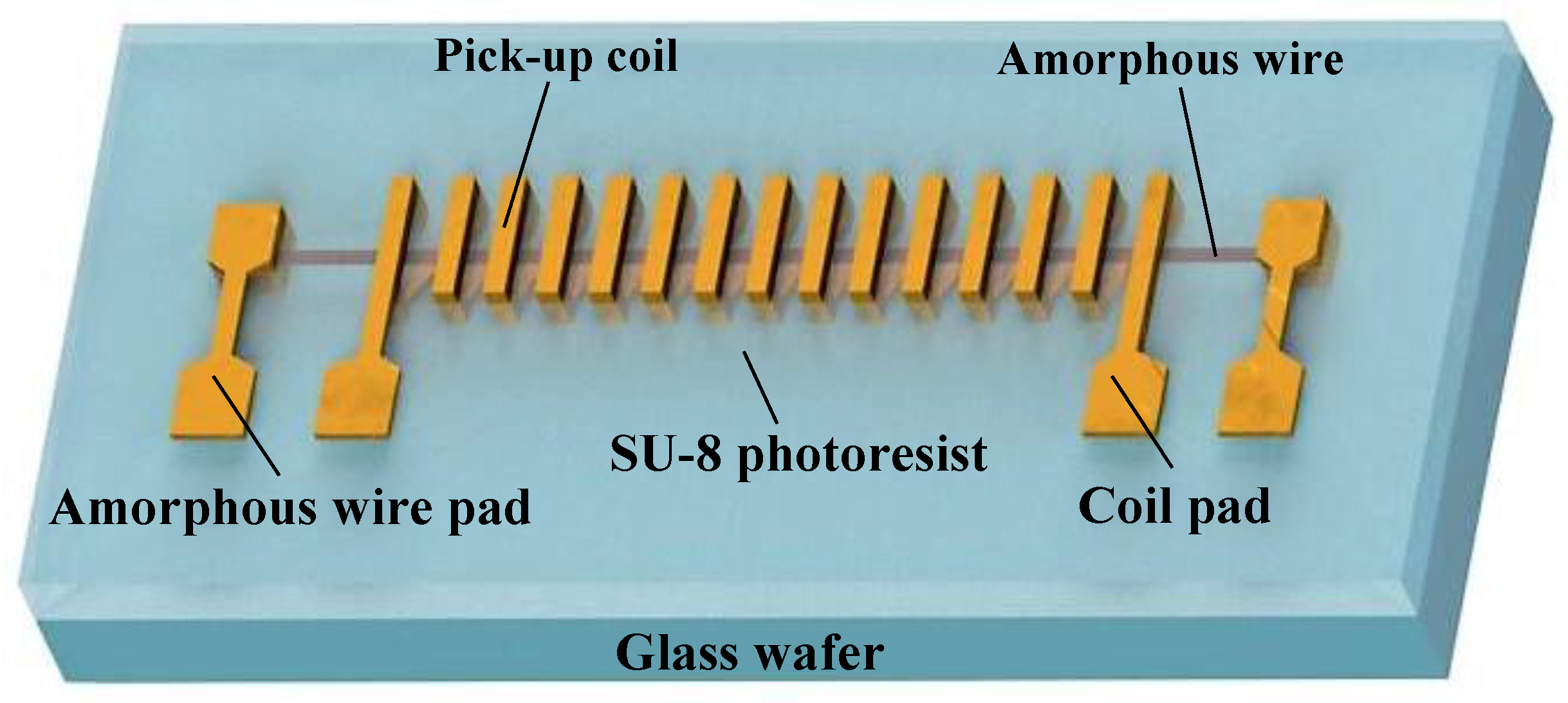

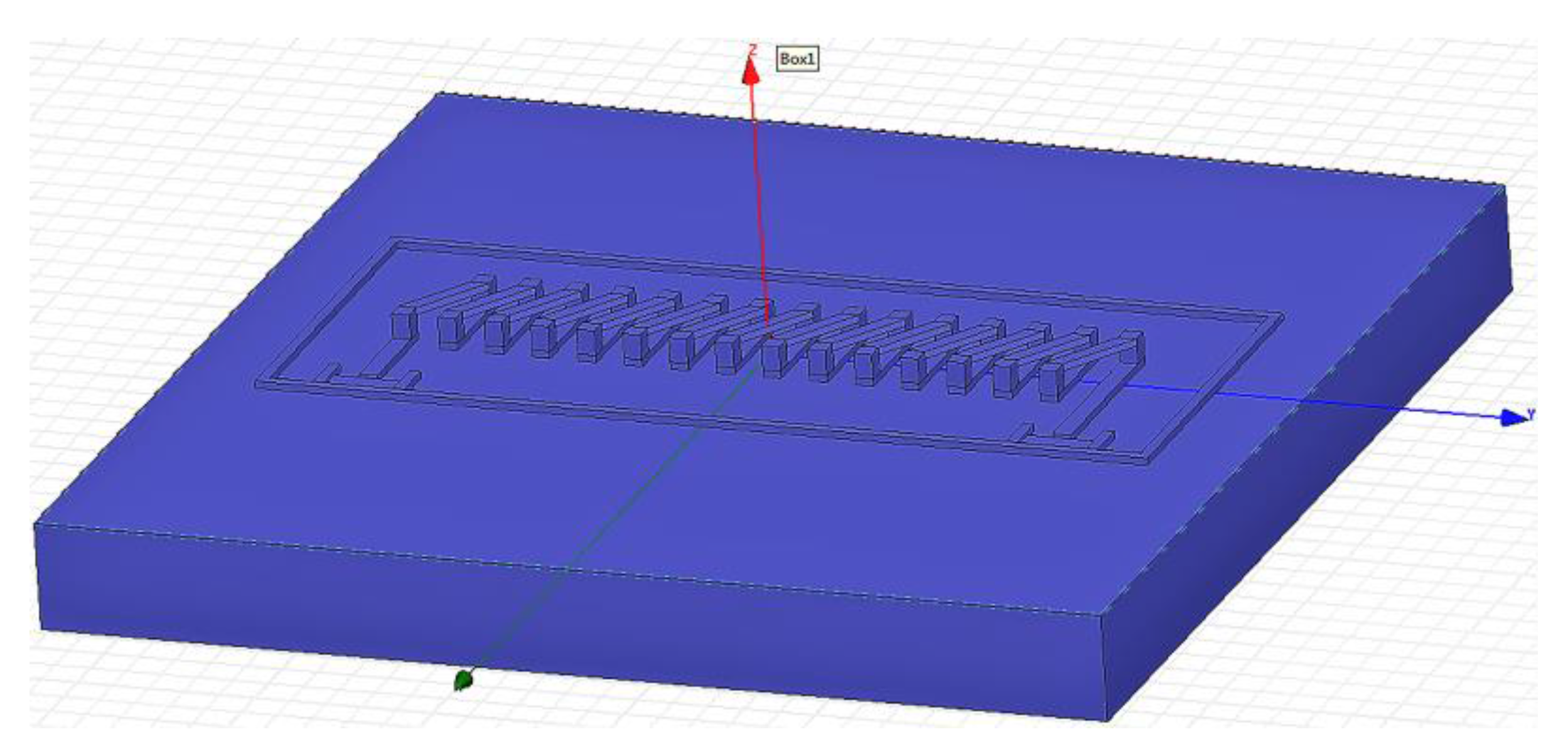
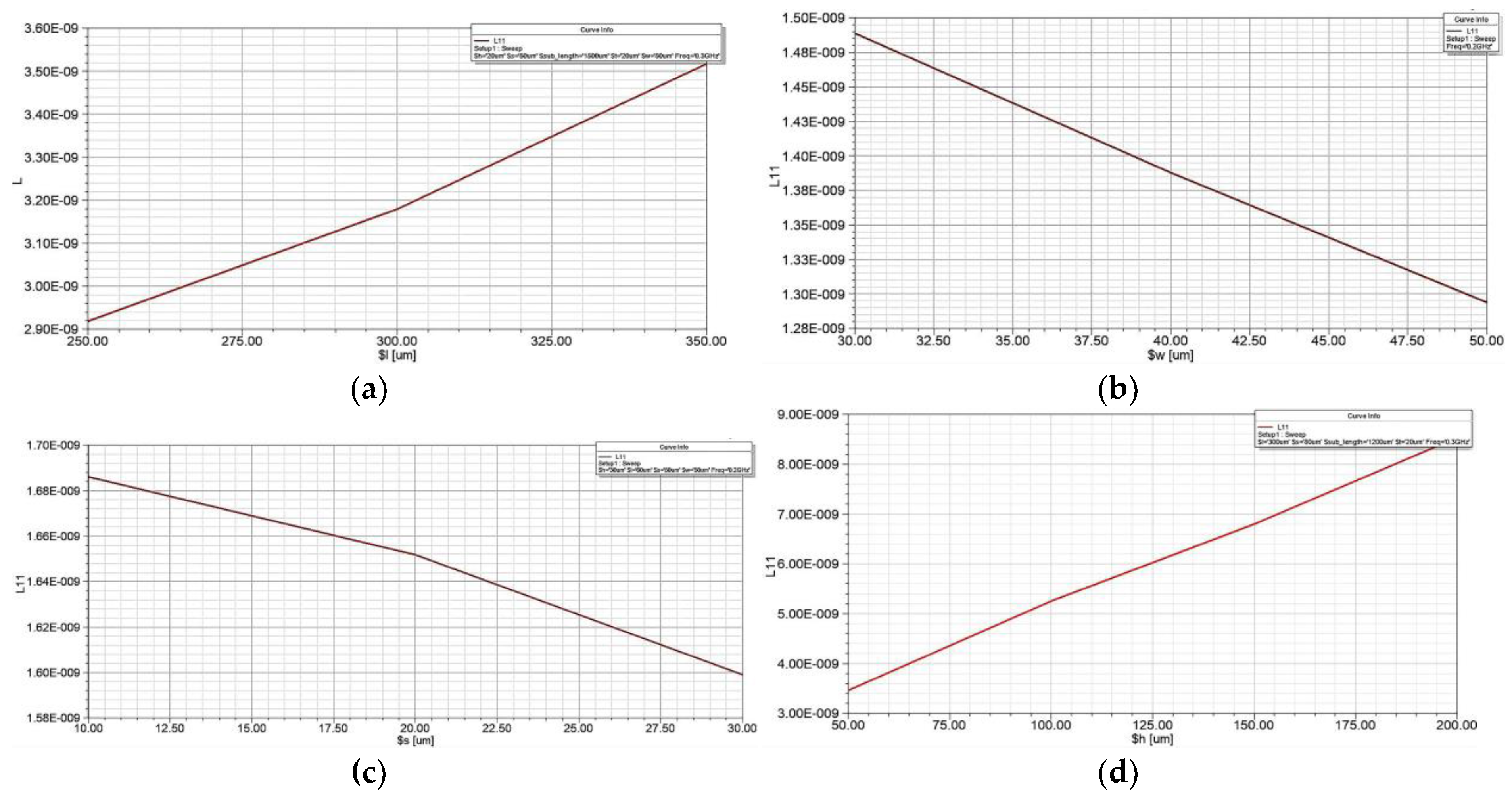
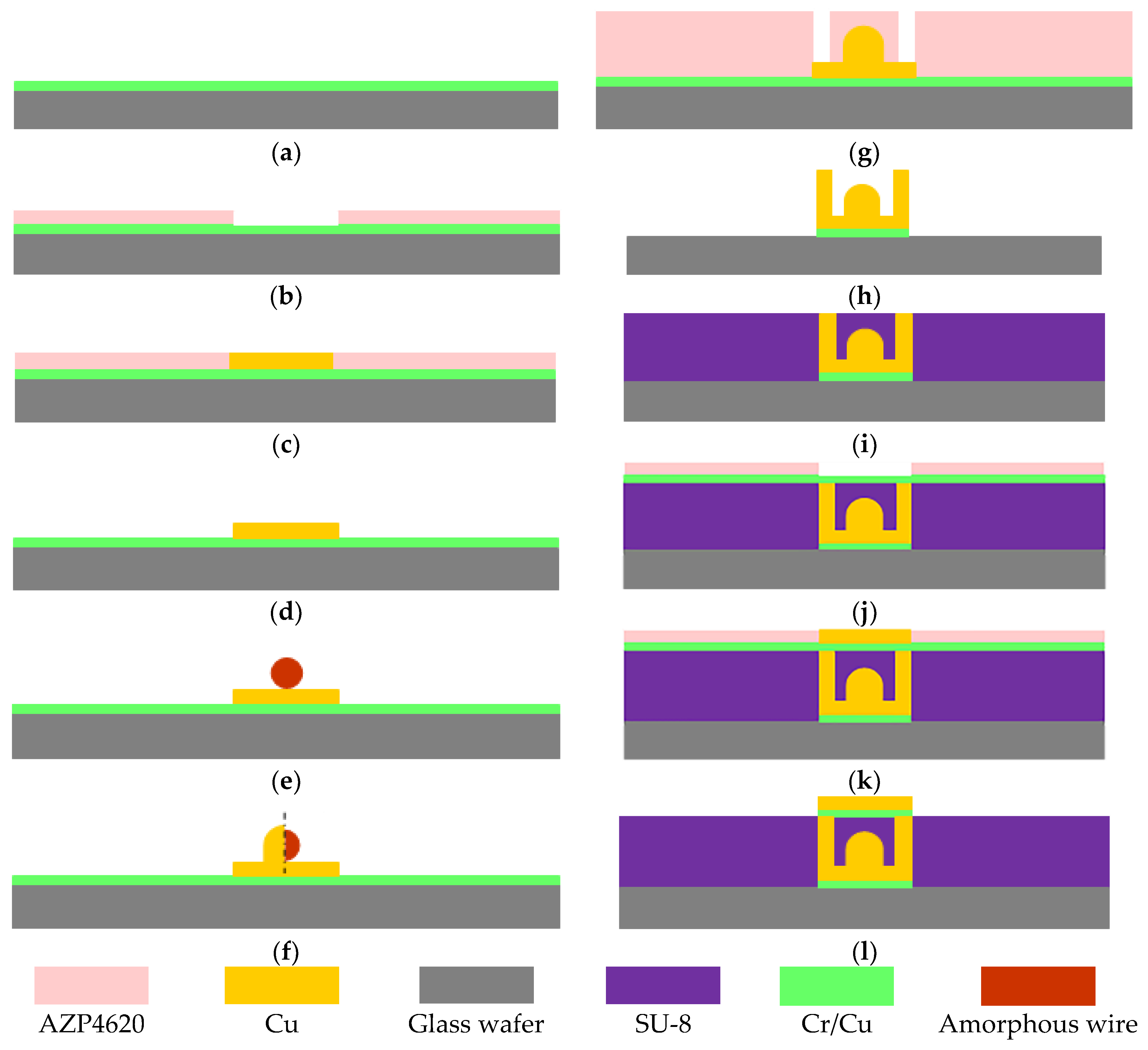


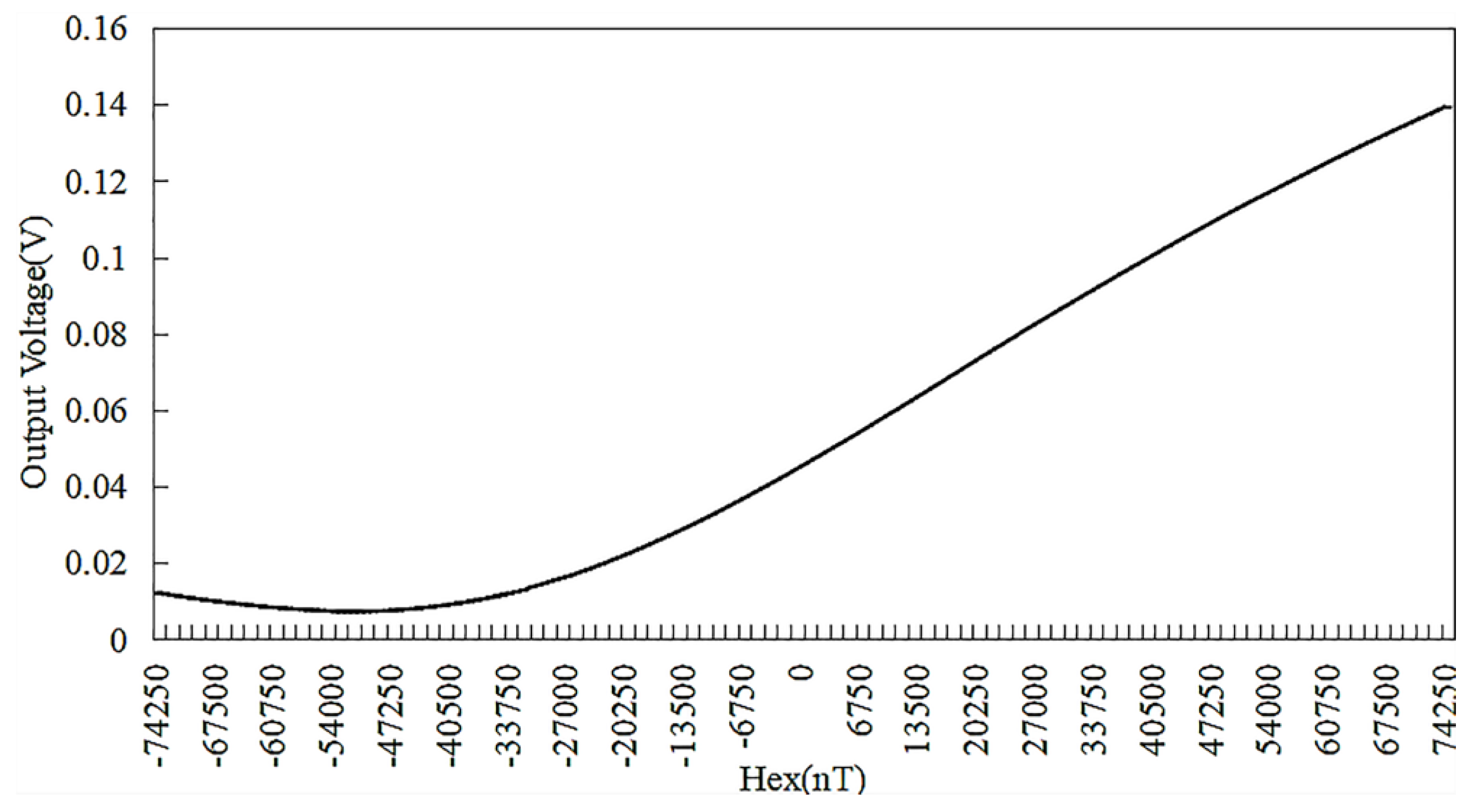

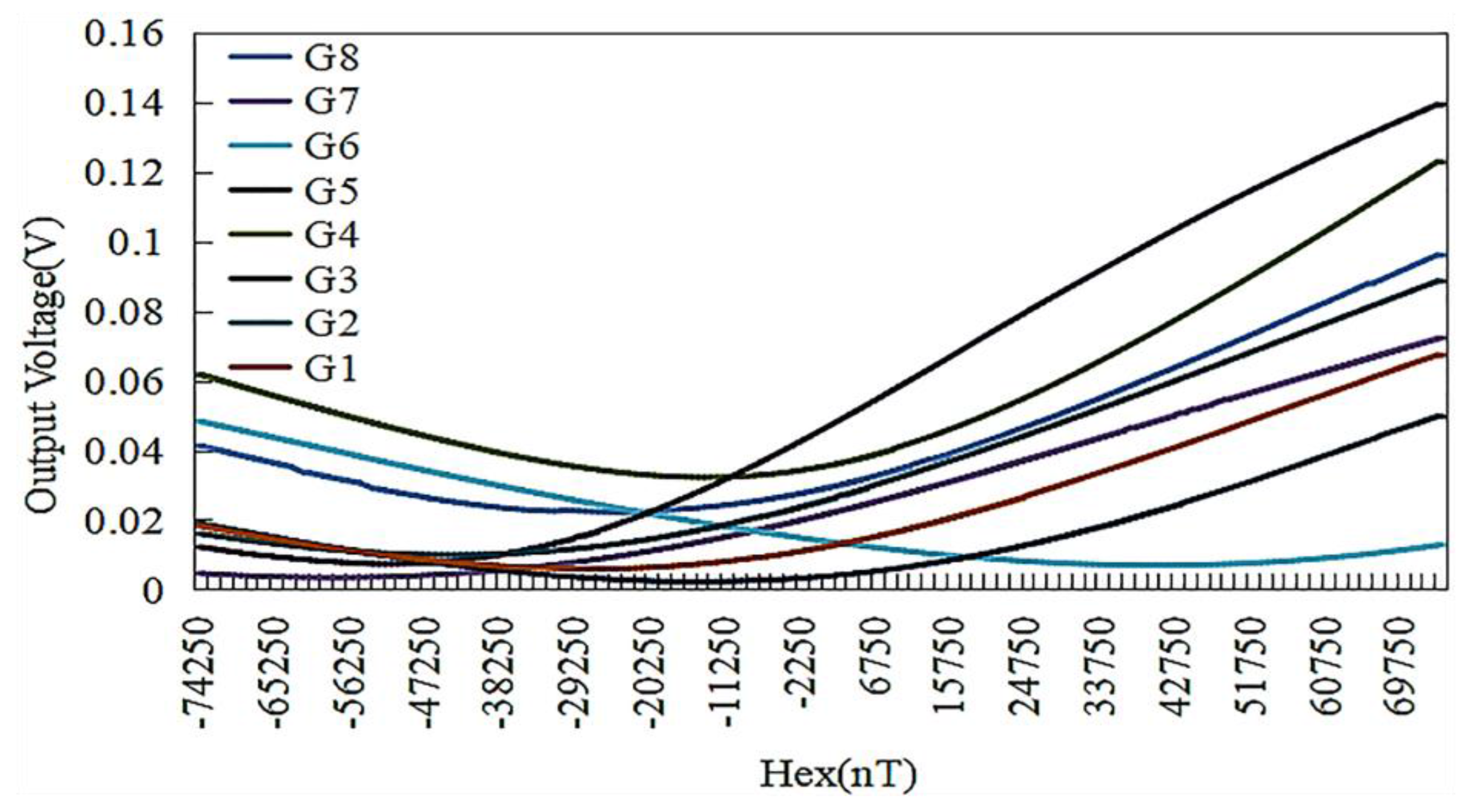
| Type | Size | Sensitivity | Fabrication Method |
|---|---|---|---|
| Magnetic detector with conducting layer | amorphous wire diameter: 30 µm, length: 3 mm; pick-up coil diameter: 200 µm, turns: 30. | 65 mV/Oe in the range of −3 Oe~+3 Oe | welding, artificial winding |
| Differential-type integrating GMI (Giant magneto-impedance) magnetic sensor | amorphous wire diameter: 125 µm, length: 20 mm; pick-up coil diameter: 0.2 mm, turns: 200. | 748 mV/Oe in the range of −2 Oe~+2 Oe | welding, artificial winding |
| Magnetometer based on the off-diagonal GMI (Giant magneto-impedance) effect | amorphous wire diameter: 10.7 µm, length: 10 mm; pick-up coil diameter: 50 mm, turns: 85. | Measuring range: ±250 µT | welding, artificial winding |
| Magnetometer/Accelerometer | 1 × 1 mm2 | magnetic field sensitivities: 1.57 pF/T Acceleration sensitivities: 1.02 fF/g | MEMS (Micro-Electro-Mechanical System) |
| Micro-fluxgate sensor with double-layer magnetic core | 7.3 × 2.7 mm2 | 1985V/T in the range of −1.05 mT~+1.05 mT | MEMS (Micro-Electro-Mechanical System) |
| Torsion MEMS (Micro-Electro-Mechanical System) magnetic sensor with permanent magnet | 3.09 × 3.09 mm2 | in-plane magnetic field: 2.86 mV/µT out-of-plane magnetic field: 6.57 mV/µT | MEMS (Micro-Electro-Mechanical System) |
| Parameter of the Pick-up Coil | Value (µm) |
|---|---|
| wire length, l | 350 |
| wire width, w | 30 |
| wire space, s | 20 |
| pillar height, h | 100 |
| Number | Amorphous Wire Resistance (Ω) | Coil Resistance (Ω) | The Maximum Voltage (V) | The Minimum Voltage (V) |
|---|---|---|---|---|
| G1 | 12.386 | 0.771 | 210 | 23 |
| G2 | 12.40 | 1.10 | 172 | 20 |
| G3 | 12.280 | 1.31 | 182 | 32 |
| G4 | 12.574 | 0.782 | 230 | 26 |
| G5 | 12.425 | 0.850 | 144 | 16 |
| G6 | 12.256 | 1.030 | 240 | 28 |
| G7 | 12.113 | 1.236 | 224 | 30 |
| G8 | 12.706 | 0.676 | 122 | 18 |
© 2018 by the authors. Licensee MDPI, Basel, Switzerland. This article is an open access article distributed under the terms and conditions of the Creative Commons Attribution (CC BY) license (http://creativecommons.org/licenses/by/4.0/).
Share and Cite
Chen, J.; Li, J.; Li, Y.; Chen, Y.; Xu, L. Design and Fabrication of a Miniaturized GMI Magnetic Sensor Based on Amorphous Wire by MEMS Technology. Sensors 2018, 18, 732. https://doi.org/10.3390/s18030732
Chen J, Li J, Li Y, Chen Y, Xu L. Design and Fabrication of a Miniaturized GMI Magnetic Sensor Based on Amorphous Wire by MEMS Technology. Sensors. 2018; 18(3):732. https://doi.org/10.3390/s18030732
Chicago/Turabian StyleChen, Jiawen, Jianhua Li, Yiyuan Li, Yulong Chen, and Lixin Xu. 2018. "Design and Fabrication of a Miniaturized GMI Magnetic Sensor Based on Amorphous Wire by MEMS Technology" Sensors 18, no. 3: 732. https://doi.org/10.3390/s18030732





